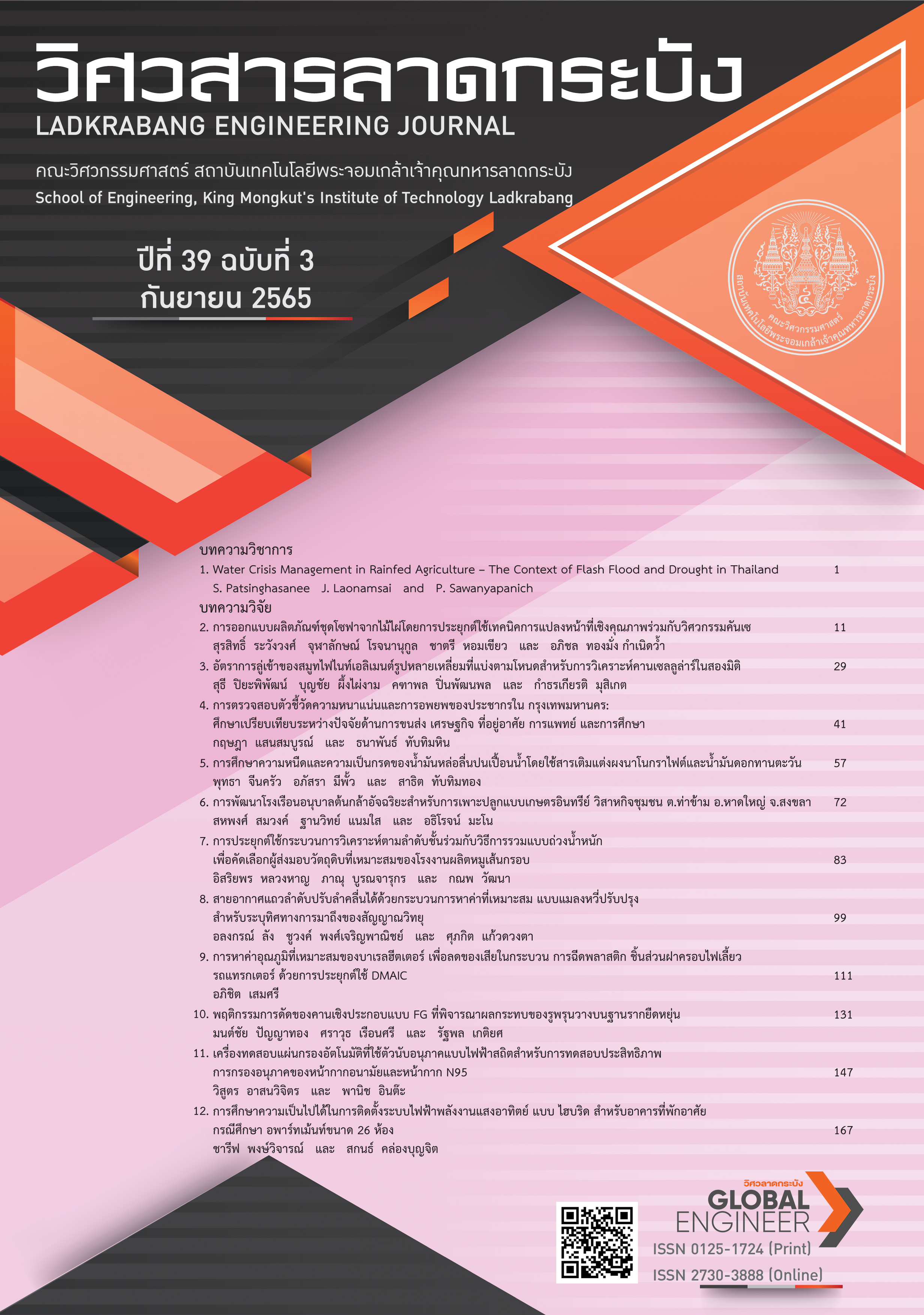Convergence Rate of N-sided Polygonal Node-based Strain Smoothed Finite Element for 2D Castellated Beam Analysis
Keywords:
N-Sided Polygonal element, Node-based strain smoothed finite element, free and forced vibrations, castellated beamAbstract
N-Sided polytype smoothed finite element based on polygonal-node for two-dimensional problem is presented. Polygonal elements obtained from different algorithms namely DistMesh and PolyMesher will be further divided into small quadrilateral shape, referred as smoothing cells or elements, around the corresponding polygonal nodes. Benchmark problem was a castellated beam punched with five holes along its longitudinal axis representing discontinuous problem domain. Its far free edge is subjected to vertical shear traction while the opposite ended is designed as fixed support. Three analyses were investigated including static, free vibration, and transient vibration, respectively. For sake of simplicity, a lumped mass matrix is assumed to avoid numerical integration for shape functions. Due to its versatile yet stability and powerful time integration tool, an implicit Newmark-Beta method is employed. For static analysis, PolyMesher has shown better performance significantly for both accuracy and convergence rate to close-to-exact solution than DistMesh. Contradictory, although the results from free and forced dynamic analyses have shown in good agreement with close-to-exact solutions, a slightly better performance on DistMesh can be observed for free vibration. It is worth noting that the differences of results between both polygonal element creation are very small and negligible but not applicable for static case.
References
K. J. Bathe, “An Introduction to the Use of Finite Element Procedures,” in Finite Element Procedures, Hoboken, NJ, USA: Prentice Hall, 1996, ch. 1, sec. 1.1-1.4, pp. 1–14.
O. C. Zienkiewicz, R. L. Taylor and J. Z. Zhu, “The Standard Discrete System and Origins of the Finite Element Method,” in The Finite Element Method: Its Basis and Fundamentals, 6th ed., Waltham, MA, USA: Elsevier Butterworth-Heinemann, 2005, ch. 1, sec. 1.1–1.8, pp. 1–12.
T. J. Hughes, “Fundamental Concepts: A Simple One-dimensional Boundary-Value Problem,” in The Finite Element Method: Linear Static and Dynamic Finite Element Analysis, Mineola, NY, USA: Dover Publication, 2000, ch. 1, sec. 1.1–1.15, pp. 1–44.
G. R. Liu and T. T. Nguyen, “Introduction,” in Smoothed Finite Element Methods, 1st ed., Boca Raton, FL, USA: CRC Press, 2010, ch. 1, sec. 1.1–1.7, pp. 1–11.
G. R. Liu, “The smoothed finite element method (S-FEM): A framework for the design of numerical models for desired solutions,” Frontiers of Structural and Civil Engineering, vol. 13, no. 2, pp. 456–477, 2019, doi: 10.1007/s11709-019-0519-5.
W. Junchum, K. Musiket, B. Phungpaingam and P. Pongsivasathit, “Two-Dimensional plane stress analysis by smoothed finite element method using 4 smoothing cells created by an arbitrary quadrilateral element,” Engineering Journal of Research and Development, vol. 32, no. 3, pp. 33–51, 2021. (in Thai)
M. J. Kazemzadeh-Parsi and F. Daneshmand, “Solution of geometric inverse heat conduction problems by smoothed fixed grid finite element method,” Finite Elements in Analysis and Design, vol 45, no. 10, pp. 599–611, 2009, doi: 10.1016/j.finel.2009.03.008.
J. Liu, Z. -Q. Zhang and G. Zhang, “A smoothed finite element method (S-FEM) for large-deformation elastoplastic analysis,” International Journal of Computational Methods, vol 12, no. 4: pp. 1540011, 2015, doi: 10.1142/S0219876215400113.
E. Li, Z. Zhang, C. Chang, S. Zhou, G. R. Liu and Q. Li, “A new homogenization formulation for multifunctional composites,” International Journal of Computational Methods, vol 13, no. 2, pp. 2016, Art. no. 1640002, doi: 10.1142/S0219876216400028.
P. O. Persson and G. Strang, “A simple mesh generator in MATLAB,” SIAM review, vol. 46, no. 2, pp. 329–345, 2004, doi: 10.1137/S0036144503429121.
C. Talischi, G. H. Paulino, A. Pereira and I. F. Menezes, “PolyMesher: a general-purpose mesh generator for polygonal elements written in MATLAB,” Structural and Multidisciplinary Optimization, vol. 45, pp. 309–328, 2012, doi: 10.1007/s00158-011-0706-z.
C. Talischi, G. H. Paulino, A. Pereira and I. F. Menezes, “PolyTop: a MATLAB implementation of a general topology optimization framework using unstructured polygonal finite,” Structural and Multidisciplinary Optimization, vol. 45, pp. 329–357, 2012, doi: 10.1007/s00158-011-0696-x.
L. Kobbelt. “OpenMesh”, openmesh.org. https://www.graphics.rwthaachen.de/software/openmesh/
E. T. Ooi, C. Song, F. Tin-Loi and Z. Yang, “Polygon scaled boundary finite elements for crack propagation modelling,” International journal for numerical methods in engineering, vol. 91, no. 3, pp. 319–342, 2012, doi: 10.1002/nme.4284.
I. M. Smith, D. V. Griffiths, and L. Margetts, “Forced Vibrations,” in Programming the finite element method, 5th ed., Hoboken, NJ, USA: John Wiley & Sons, 2013, ch. 11, sec. 11.1–11.7, pp. 483–508.
D. L. Logan, “Structural Dynamics and Time-Dependent Heat Transfer,” in A first course in the finite element method, 6th ed., Boston, MA, USA: Cengage Learning, Inc., 2017, ch. 16, sec. 16.3, pp. 764–780.
K. Y. Dai, G. R. Liu and T. T. Nguyen, T. T., “An n-sided polygonal smoothed finite element method (nCSFEM) for solid mechanics,” Finite elements in analysis and design, vol. 43, no. 11–12, pp. 847–860, 2007, 10.1016/j.finel.2007.05.009.
Abaqus G. Abaqus 6.11. Dassault Systemes Simulia Corporation, Providence, RI, USA. 2011
Downloads
Published
How to Cite
Issue
Section
License
Copyright (c) 2022 Faculty of Engineering, King Mongkut’s Institute of Technology Ladkrabang

This work is licensed under a Creative Commons Attribution-NonCommercial-NoDerivatives 4.0 International License.
The published articles are copyrighted by the School of Engineering, King Mongkut's Institute of Technology Ladkrabang.
The statements contained in each article in this academic journal are the personal opinions of each author and are not related to King Mongkut's Institute of Technology Ladkrabang and other faculty members in the institute.
Responsibility for all elements of each article belongs to each author; If there are any mistakes, each author is solely responsible for his own articles.






